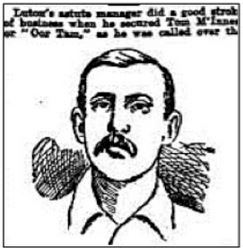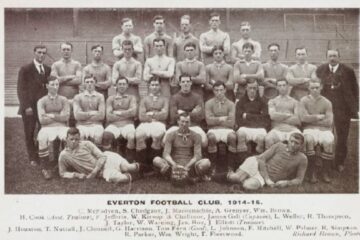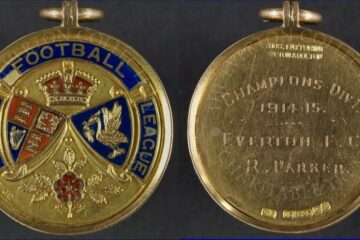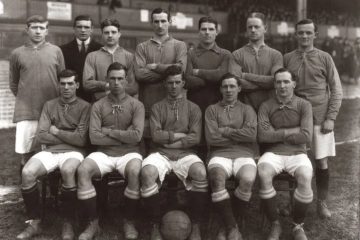[NB. This article first appeared in the run-up to the Merseyside derby April 2016]
The game will take place on the former home of Everton at Anfield before a capacity and fiercely partisan crowd. The atmosphere will be electric. Yet, when these two deadly rivals first locked horns, it was not at one of their present day homes but on a cricket ground before a crowd of 10,000 people at Hawthorne Road in Bootle. The month was April 1893 and the occasion was the final of Liverpool Senior Cup.
As the match approached, and because the season was already at an end, there was much local speculation about whether the team from Goodison Park would include any of its Football League players, or whether they would leave the game in the care of the second string of players from their Combination eleven which had brought them to this stage of the competition. In the event, they chose to field eight of the latter side and reinforced it with three first-team players.
Liverpool, who were in their first season of existence, had recently pipped Blackpool on goal average to become champions of the Lancashire League with a team of players who had mostly been imported from Scotland. They had struggled at first to find some cohesion, but were now beginning to blend into a competent side. In a concerted effort to win the trophy, they fielded their best available eleven.
Herbie Arthur, the former Blackburn Rovers and England goalkeeper, took charge in the middle as the play commenced. As anticipated, the game was a fiercely competitive affair and it ended in controversy. Tom Wylie, a former Everton player, gave Liverpool a first-half lead that they were holding when, in the last minute of the game, their opponents took a corner kick which landed in their goal mouth. Mayhem ensued as the Everton players, appealing for penalty kick, claimed the ball had been fisted clear by one of their opponents.
Mr. Arthur consulted his linesman, Arthur Bertram Hull, who ruled in favour of Liverpool and, after being thrown in the air, the ball was kicked clear. Moments later the final whistle was sounded. The Everton executive lodged a protest against the general incompetence of the former England goalkeeper, so the awarding of the trophy was delayed until after a meeting of Liverpool & District FA. Eventually it was awarded to Liverpool who then made an outrageous, and ultimately successful, bid to join the Football League.
Representatives of the member clubs met 26 May, 1893, at Chancery Lane in London to decide the various issues that were open to debate. Based on the results of a series of test matches, the first item on the agenda confirmed the clubs which would compete in Division One the following season. Newton Heath, who had won their test match, were re-elected while Accrington and Notts County were relegated, after being beaten by Darwen and Sheffield United respectively. The committee then moved on to discuss the issues which related to Division Two.
The members discussed whether the number of clubs in the division should be increased from twelve to fourteen but, on a proposal put forward by Grimsby Town, it was decided to increase the number to sixteen. Applications to fill these vacancies were received from Liverpool, Newcastle United and Rotherham Town. According to the newspaper report below, the Liverpool executive had the chutzpah to attempt to leapfrog over the Division Two clubs and be elected directly into the First Division of English football.
The committee chairman, however, pointed out to them that this was against the rules, so Newcastle United and Rotherham Town were duly elected. Liverpool then had five days before the next meeting to reapply for one of the two vacancies that still existed. They did so and, along with Woolwich Arsenal, were elected to Division Two of the Football League. Accrington, who were experiencing financial difficulties, decided not to reapply for membership so their place was awarded to Middlesborough Ironopolis.

The Football League committee then drew up a list of fixtures which were issued to the public 5 June. Liverpool, it had been decided, would meet neighbours Bootle at Hawthorne Road 10 February, while the return match would be played at Anfield 23 March. However these matches never took place because in the middle of August the Hawthorne Road executive announced that they could no longer survive in the financial climate of the day and thus became the first football club to resign from the Football League.
Their untimely resignation came too late for the FA to bring in a replacement club so, for the only time in its history, the Football League Division Two season was played out between an uneven number of clubs. Liverpool, who were undefeated, won the title with ease and, on being elected to Division One, laid the foundations for the first Football League game that was to be played between Everton and Liverpool. In the meantime, the Goodison Park club had signed a player from Scotland who would write his name firmly in to the folklore of Merseyside football. His name was Thomas McInnes.

He had been born 22 March, 1869 in Glasgow where he began his senior football career with the Cowlairs club. It was while playing for this now defunct club that he won his one and only international cap when he represented Scotland 9 March 1889 in a 7-0 win over Ireland where he scored one of the goals. That summer, at the invitation of Notts County, he moved south and began playing his football on the Plains of Albion. “Tam” soon became a great favourite with the crowd at Trent Bridge and represented the Nottingham club in the 1891 FA Cup Final against Blackburn Rovers where they were beaten by three goals to one. He remained with the “Lacemen” for three seasons before returning to his native Glasgow where he continued his football career with Third Lanark.
On 19 April 1894 the Cathkin Park club, which included McInnes, appeared at Goodison Park in a fixture that was arranged for the benefit of former Everton player Daniel Kirkwood whose career was ended by injury while playing for Liverpool Caledonians. It is fairly safe to assume that during this time McInnes was persuaded by the Everton executive to return to Liverpool the following season and to resume playing professional football in England. The Scot scored on his debut against Sheffield Wednesday and had added three more goals by the time Everton, who had won their opening seven games, faced Liverpool for the first time at Goodison Park.
The occasion produced sights never before seen in the Mersey seaport as thousands of people descended on the Everton ground from all directions. The attendance was given as 44,000 while £1,026 was taken at the gate. Nothing approaching these figures had ever been known in the history of the Football League. The play had been in progress for just ten minutes when Bill “Soldier” Stewart sent over a cross that was headed home by Tam McInnes to give Everton a first-half lead. Two further second-half goals, scored by Alex Latta and Jack Bell, gave the home side a comfortable 3-0 victory.
Tam McInnes went on to play forty-seven Football League and FA Cup games for Everton, scoring eighteen goals in the process, before signing during the spring of 1895 for a Luton Town side who had just become members of the Football League. He settled with his wife and two children in the Bedfordshire town and later played for both Bristol Rovers and Bedford Queen Engineers before retiring from the game in 1901 to work in an iron foundry. Thomas McInnes, the first man to score for Everton in a Merseyside derby game, died in Luton in 1939.




